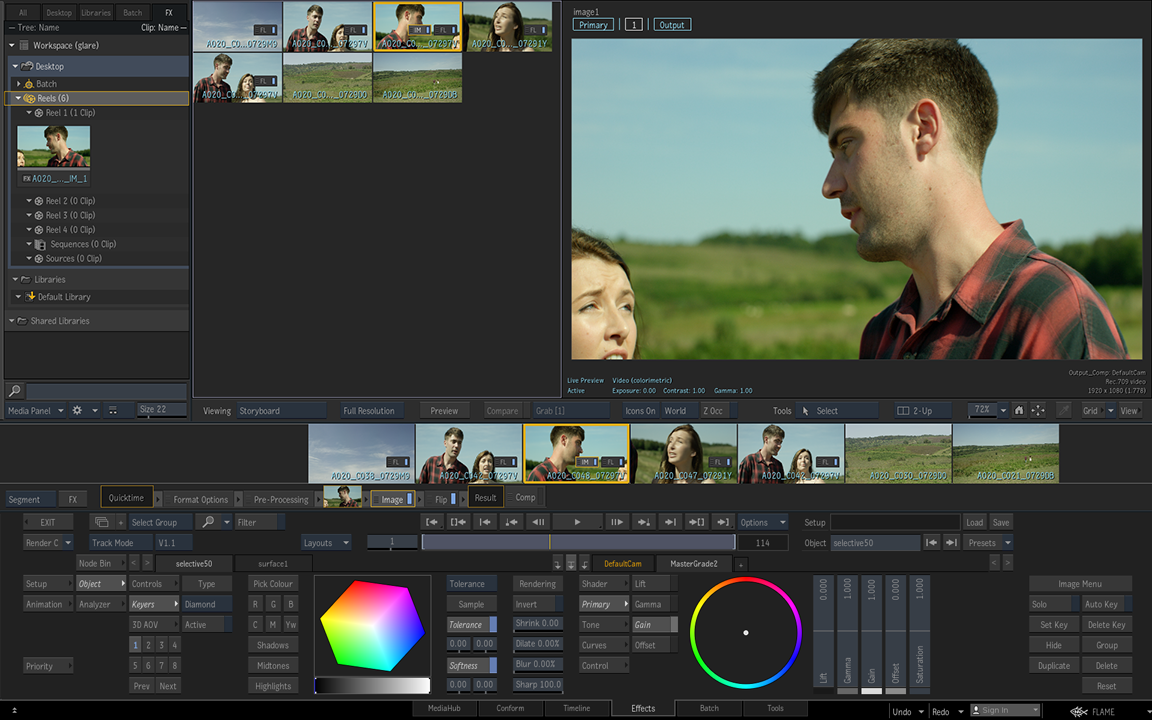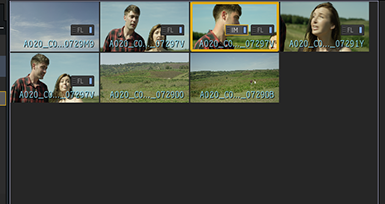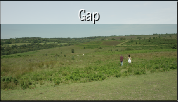The Video Timeline FX editor have been replaced with a new tab located at the bottom of the screen, the Effects environment.
Double-clicking a Timeline Segment or a Timeline FX button, or clicking the Editor button now brings you to the Effects environment.
 For additional details, see this playlist from the Flame Learning Channel:
The Effects Environment.
For additional details, see this playlist from the Flame Learning Channel:
The Effects Environment.

Storyboard
There are two Storyboards available in Effects: a Reel and a View. Reel and the View are two methods to view the segments from the currently selected track.
The Storyboard Reel presents segments available in the current sequence, and is enabled by default. The Storyboard View is displayed in a viewport.
 See
Meet the Storyboard from the Flame Learning Channel.
See
Meet the Storyboard from the Flame Learning Channel.
Storyboard Reel

When you open Effects, the Storyboard Reel is displayed by default.
To toggle the Storyboard Reel on or off, do one of the following:
- Select .
- Use keyboard shortcut.
- Flame, Smoke Classic and Smoke (FCP7) user profiles: Alt+F1
- Lustre user profile: Tab
To navigate between segments on the Storyboard Reel:
- Click its thumbnail.
The segment currently selected is outlined in yellow.
- Use the following keyboard shortcuts:
User profile keyboard shortcuts... Go to Storyboard's... Flame, Smoke Classic, Lustre Smoke (FCP 7) Start Ctrl+Home Ctrl+Shift+Home End Ctrl+End Ctrl+Shift+End Previous Page Ctrl+PageUp Ctrl+Shift+PageUp Next Page Ctrl+PageDown Ctrl+Shift+PageDown
Storyboard View
 See
The Storyboard View from the Flame Learning Channel.
See
The Storyboard View from the Flame Learning Channel.

The alternate Storyboard View can be displayed within a viewport of the Effects environment. The Storyboard View presents the same segments as the Storyboard Reel.
The main difference, aside from the layout, is the fact that you can zoom in and out of the Storyboard view, as well as pan the Storyboard, just as you would any other viewport.
To toggle the Storyboard View on or off, do one of the following:
- From the Viewing menu, select Storyboard.
- Use the keyboard shortcut for the Storyboard View:
- Flame user profile: Shift+F1
- Smoke Classic and Smoke (FCP7) user profiles: Meta+F1 (Linux) or Command+F1 (macOS)
- Lustre user profile: Q
Storyboard Thumbnails
Storyboard thumbnails can display the segment's name, any applied Timeline FX and their status. You can also scrub thumbnails.
In the Storyboard View or Reel:
- There is a thumbnail for every segment on the track or in the version.
- The thumbnail currently selected syncs with what is displayed in the viewport. Unless you've set a Thumbnail Icon, in which case the thumbnail always reverts to the set frame.
- Every applied Timeline FX is displayed on the thumbnail if there is enough room. If not, a button is displayed with an ellipsis (...).
- A hatched pattern appears on the top-third of a thumbnail when the segment is locked in Timeline.
Note: This can only happen in Sources or Versions modes, and segments from a locked tracked are shown.
- A darkened thumbnail indicates a muted segment.

To customize the information displayed on Storyboard thumbnails:
- Selection option in .
To set a thumbnail icon, do one of the following:
- Select Set Frame Thumbnail Icon, from the Storyboard contextual menu.
- Use the keyboard shortcut:
- Flame, Smoke Classic and Lustre user profiles: Alt+Q.
- Smoke FCP user profile: Meta+P.
Thumbnail scrub bar:
- The scrub bar automatically appears when you hover the bottom third of a thumbnail.
- A hatched scrub bar indicates a Thumbnail Icon is set. You can still scrub the thumbnail, but it will snap back to the set frame once you stop scrubbing.
- The scrub bar is not available to the thumbnail currently displayed in the viewport.

|
Scrub bar displayed. |

|
Scrub bar with a hatched pattern indicates a reference frame is set for this thumbnail. |

|
This thumbnail is actually a Gap, not a timeline segment with media.
The media displayed is that of the track below. Gaps are only displayed when the Storyboard is sorted by Track Mode. |

|
A hatched pattern indicates the segment is locked in Timeline.
Locked segments only appear when the Storyboard is sorted by Versions or Sources modes. |

|
The thumbnail of a segment muted in Timeline.
Muted segments are displayed only when the Storyboard is sorted by Track Mode. |
Sorting and Filtering the Storyboard
 See
Sorting the Storyboard and
Filtering and Searching from the Flame Learning Channel.
See
Sorting the Storyboard and
Filtering and Searching from the Flame Learning Channel.

(From left to right)
- The Storyboard Sort box
- The Track and Version Selection box
- The Filter button
- The Search button
To display in the Storyboard only selected segments:
- Select the thumbnails to filter for.
- Enable Filter.
The Storyboard only displays the thumbnails you selected. Disable Filter to display the rest of the storyboard.
Tip: Use the Filter option in conjunction with Search to display a Storyboard that shows only segments sharing similar properties.
To display the contents of a track:
- Set Storyboard Sort to Track Mode.
- Select the track from Track and Version Selection.
To display the contents of a version, ordered by record timecode:
- Set Storyboard Sort to Version Mode.
- Select the version from Track and Version Selection.
To display the contents of a version, ordered by tape name and source timecode:
- Set Storyboard Sort to Sources Mode.
- Select the version from Track and Version Selection.
Storyboard Sort box
Change how the segments are sorted in the Storyboard with the Storyboard Sort box.
- Track Mode
- Displays the segments of a single track, including gaps, in chronological order. You change track using the Track and Version Selection box.
- Version Mode
- Displays every segment from every track within the selected Timeline version, ordered by Record Timecode. If two segments share the same Record Timecode, then the top-most segment is displayed first. Gaps are not displayed in this mode. You select a version using the Track and Version Selection box.
- Sources Mode
- Displays every segment from every track within the selected Timeline version, ordered by Tape name and Source Timecode. If the same source is present multiple times within the same version, the source is displayed multiple times inside the Storyboard. The Record Timecode is used to determine which segment is presented first. Gaps are not displayed in this mode. You select a version using the Track and Version Selection box.
Selecting Thumbnails on the Storyboard
The first thumbnail selected has a yellow border. Thumbnails added to the selection have an orange border.

The following shortcuts are available:
Select a thumbnail:
- Click the thumbnail in the Storyboard View or Reel.
Add to selection:
- Ctrl+click in the Flame, Smoke Classic and Lustre user profiles.
- Meta+click (Linux) or Command+click (Mac) in the Smoke FCP user profile.
Select up to click:
- Shift+click in all user profiles.
Select All:
- Ctrl+A in the Flame and Lustre user profiles.
- Keypad / in the Smoke Classic profile.
- Meta+A (Linux) or Command+A (Mac) in the Smoke FCP user profile.
Deselect:
- Ctrl+Shift+A in the Flame and Lustre user profiles.
- Keypad * in the Smoke Classic profile.
- Meta+Shift+A (Linux) or Command+Shift+A (Mac) in the Smoke FCP user profile.
Selecting by Searching
You can select segments using the Timeline Search, as described in Searching the Timeline.
Note that you cannot search for Audio Timeline FX and Transitions, as they are not available in Effects. Gaps can only searched for when Storyboard Sort is set to Track Mode.
And while you can search for Markers and Segments Markers, the search result displays the segments under the found markers, not the markers themselves.
Managing the Timeline FX Pipeline in Effects
 See
Working with Timeline FX from the Flame Learning Channel.
See
Working with Timeline FX from the Flame Learning Channel.
Operations on Timeline FX in Effects are similar to what can be done in Timeline, but the presence of the Storyboard changes a few key operations.
To copy a Timeline FX in Effects:
- Drag the FX from the Timeline FX Pipeline, and drop it on another thumbnail in the Storyboard.
- Drag the FX from a thumbnail on the Storyboard and drop it on another thumbnail.
Tip: If you first multi-select thumbnails, drag & drop an Timeline FX on one of the selected thumbnails to copy the effect to all selected thumbnails.
To copy a Timeline FX to multiple thumbnails in Effects:
- Select the target segments, using Ctrl+Click or Search.
- Drag the FX from a thumbnail on the Storyboard and drop it on one of the selected thumbnails.
To delete a Timeline FX from a segment in Effects:
- Alt+Click on the Timeline FX within the Timeline FX pipeline or the Storyboard.
- Select Delete from the Timeline FX contextual menu.
- Drag the Timeline FX button from the Timeline FX Pipeline to the bottom of the screen.
- Drag the Timeline FX button from the Storyboard to the bottom of the screen.
Tip: Select more than one segment, and then when you delete a Timeline FX from one thumbnail, you delete that Timeline FX from every selected thumbnails.
Bypassing a Timeline FX
In the Effects environment, you can bypass a Timeline FX by clicking its LED in the Timeline FX ribbon.
Viewing a bypassed FX is similar to viewing its input, or the output of the previous FX in the Timeline pipeline.
 An enabled FX |
 A bypassed FX |
Some FX behave somewhat differently in Effects, even if the FX is correctly bypassed:
- When you bypass a Text FX, the Text FX view displays the Back since there is no Input in the Text FX module.
- Sparks generators such as Aurora have no input: in the Sparks view, bypassing the Sparks effect does not hide the generated frame.
Transient Timeline FX

This FX is a placeholder, a temporary effect to keep you working in Effects as you select thumbnails without any Timeline FX.
As soon as you add an FX to a thumbnail, the transient effect disappears.
As soon as you delete the last Timeline FX from a thumbnail, the Transient FX appears. But it cannot be rendered, and it has not impact on playback.
A Transient FX is just that: transient.
Rendering
 See
Interactive Render and Performance from the Flame Learning Channel.
See
Interactive Render and Performance from the Flame Learning Channel.
Render your Timeline FX pipeline from Effects. This is similar to rendering in Timeline, but with more control over what FX are rendered.
To render an FX:
- Click Render.
- Select a rendering options in the contextual menu of the Timeline FX Pipeline .
Note: The options available in the contextual menu are set by the option selected in the Render drop-down button.
- Use a keyboard shortcuts, to be defined in the
manager:
- Render Current Timeline FX
- Render Up To Timeline FX
- Render All Timeline FX
From the Render button, you can select the following rendering options:
- Render Current renders only the currently selected Timeline FX.
- Render Up renders all the Timeline FX in the pipeline, up to the selected one.
- Render All renders all the Timeline FX in the pipeline.
Depending on how a clip is rendered, you can see a visual representation on the render bar at the top of the clip in the Timeline FX pipeline:
| Render Bar: | State: |
|---|---|

|
Unrendered. |

|
Rendered. |

|
Partially rendered. |

|
Proxy rendered. |

|
Proxy partially rendered. |

|
Sent to Burn or Background Reactor. |
The Include Handles option is available, but is ignored when a Timeline FX is located before a Timewarp in the pipeline. In this scenario, all the handles are always rendered.
A rendered Timeline FX is automatically invalidated when you modify it or if a Timeline FX located before it in the Timeline FX pipeline is modified.
Navigating Ranges With the Effects Timebar
 See
Navigating with Ranges from the Flame Learning Channel.
See
Navigating with Ranges from the Flame Learning Channel.
When you scrub the Timebar, or play back the Storyboard, the selection is locked in, even if you scrub outside the range of the segment when in Timeline or Storyboard Range.
To have the Timebar positioner select the current segment:
- Do one of the following:
- In , enable Auto Select on Scrub.
- Hold Shift as you scrub.
Flame selects automatically the segment under the positioner when you stop scrubbing the Timebar.
When you play back the Storyboard, the displayed content is locked to the selected Thumbnail, even if the playhead ends up outside the range of the segment.
To have the playhead select the current segment:
- In , enable Auto Select on Stop.
Flame selects automatically the segment under the positioner when you stop scrubbing the Timebar.
Viewing a Segment in the Context of Other Segments
In Effects, the viewport displays the currently selected thumbnail. To view that thumbnail in context of the whole Storyboard, use the Storyboard Context view.

Thumbnail content in yellow, Context View in blue
To view content in Storyboard Context:
- Select a viewport and select .
- Select .
- Scrub the Timebar outside the segment's range to view the contents of the Storyboard.
Audio Monitoring
Even if audio tracks are not available from within Effects, you can still monitor the audio of a segment.
To enable audio monitoring:
- Set the Storyboard Sort box to Track Mode.
- From the Play drop-down, select Audio Monitoring.
Managing Selectives in Effects
In the Effects environment, you can drag and drop Image Selectives between segments, just as you can drag and drop Timeline FX between segments.

Selectives Manager
To copy a Selective between segments:
- From the Selective Manager, select a selective and drag and drop it over another segment in the Storyboard.
If you drop a selective on a segment without an Image or Action FX, the FX is created.
If a Selective with the same ID exists on the target segment, it is replaced by the dropped Selective. To avoid this, hold Shift as you drag and drop.
Drag and drop from a Surface Selective replaces or appends to the default Surface of the destination. Performing the drag and drop from a Camera Selective replaces or appends the selective to the default Camera of the destination.
To drag and drop only the effects attached to a Selective:
- Hold Space as you drag and drop the Selective from the Selective Manager.
To replace the selective but not the attached effects:
- Hold Altas you drag and drop the Selective from the Selective Manager.
For more details on Selectives management, see Navigating Selectives.
Media Panel in Effects
While in Effects, you only have access to the FX tab of the Media Panel. The FX tab filters out, from the bulk of the Media Panel, anything that is not an FX Clip.
Use the FX tab to store FX clips, and to load them onto segments: simply drag and drop an FX clip from the Media Panel onto a thumbnail.